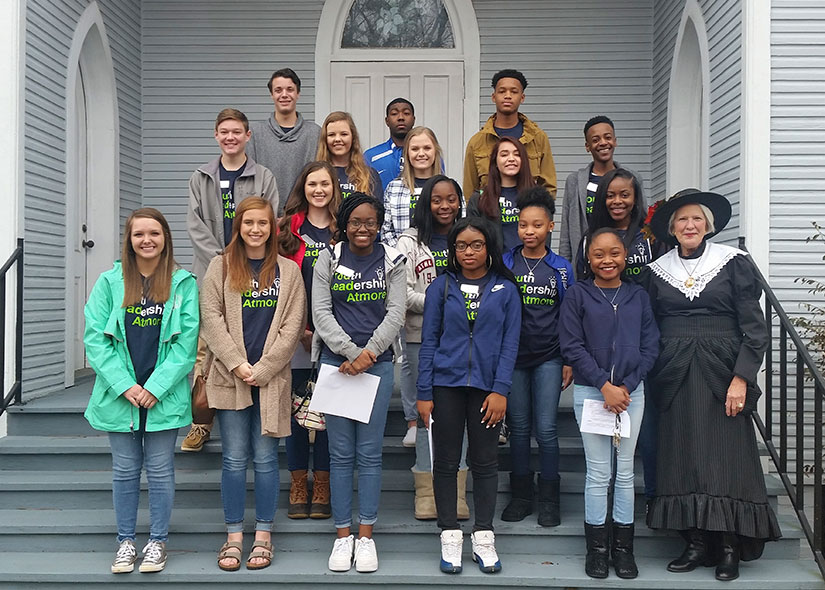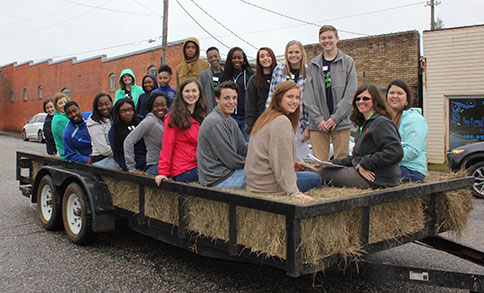
By OLIVIA SIMMONS
Special to Atmore News
On January 10th, Youth Leadership Atmore held their “Looking Ahead by Looking Back” session. This session was intended for the students to learn more about the African American, Native American, and Caucasian history of Atmore. We started our day off at Trinity Episcopal Church, the oldest church in Atmore, where we were served “sawmill” gravy and homemade biscuits. There we talked about the city’s history with “Mrs. Carney” and how Atmore came to be.
Atmore started off as Williams Station. Right before 1900, William Carney and his family moved from Mobile. His wife was a bit apprehensive, but he promised to build them a nice house. Sawmill employees were not paid in cash – they were paid in scripts. They could not exchange their scripts for cash, so as an alternative, they had to purchase the things they needed at the store located in the mill. There were no churches in Atmore so Mr. Carney decided to build one.
After the church was finished, it was open for the Baptists, Episcopalians, Catholics, and Methodists to worship there. The town soon began building family owned businesses, so it needed a name. William Carney wanted to name the town “Carney,” but was unable to since there was already a Carney located in Baldwin County. Mr. Carney then got the bright idea to name the town after a friend of his, C.P. Atmore. Unfortunately, Mr. Atmore and his family never got the chance to visit Atmore.
Next, we walked around the corner to Atmore’s oldest cemetery. Some of the graves are sunken in and a few of them do not have any head stones. We learned that Mr. Carney died from a carriage accident on the way back from Baldwin County. It felt like a once in a lifetime opportunity to walk through the cemetery because many people do not know the cemetery exists.
After walking through the cemetery, we began our hay ride tour around downtown Atmore. We were informed that the African Americans used to have a library located on Ashley Street. After segregation ended, the library was relocated to the Boy Scout Lodge. We learned that the first Rachel Patterson Elementary School was initially located at Heritage Park.
Once our tour of downtown was over, we traveled to Gaines Chapel for more African American history with Gloria Jones and Dr. Coleman Wallace. During segregation, the African Americans built everything they needed in their own neighborhood like barbershops, small grocery stores, and jewelry stores. We also enjoyed a home-cooked meal prepared by Mrs. Brenda Watkins.
Our day concluded at the Calvin McGhee Cultural Center in Poarch. The Poarch Creek Indians were the native people of the land until English settlers came to take over. The Indians were accustomed to doing everything their way, but when the settlers arrived, they were forced to experiment. Experimenting led to being servants and subjects to the settlers. Some of the Indians did not like this change and as a result, wars and battles arose. In the 1830s, President Andrew Jackson forced many tribes of Indians out of their land to Oklahoma. This became known as the Trail of Tears because many natives starved or died of sickness on the journey. Like the African Americans, the Indians were also discriminated against. Some of the prominent figures in today’s tribe can recall not being able to ride the same school bus as everyone else just because they were Indian. Chief Calvin McGhee and many others worked hard for equal rights for the tribe. In 1962, he traveled to Washington D.C. to push for the Poarch Creek Indians to be recognized by the Federal Government. Ten years later, they finally won the lawsuit and were granted around $4 million dollars for all the land that was taken from them. This session gave us more insight on how much Atmore has changed. This was a session that cannot be forgotten because everyone learned something new about the deep history and culture of the Atmore area.

